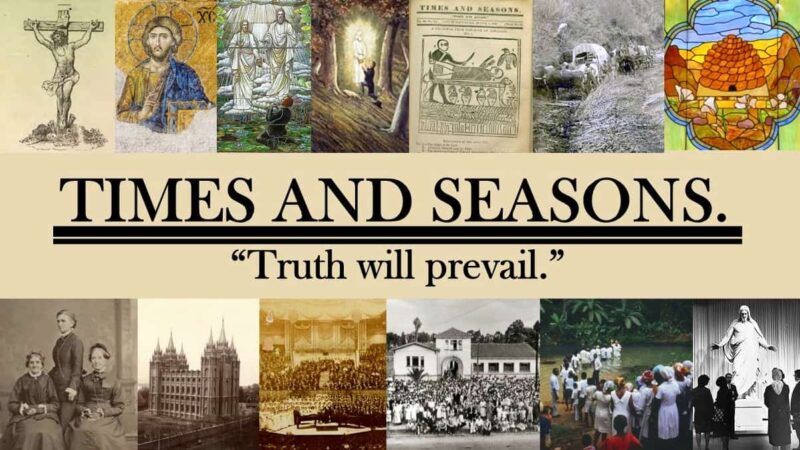
It’s an old adage in Latter-day Saint circles that the Relief Society is the “oldest women’s organization in the world.” To be fair, I searched around briefly and could not find any current Church reference to it being the oldest, just “one of the oldest,” although I did find some speculation that it was the oldest.
Still, I informally hear the unqualified bit about them being the “oldest,” so I thought some mythbusting was in order.
First, the Ladies’ Association of Philadelphia was founded in 1780 to help the Revolutionary War effort. Interestingly, their fundraised funds went to Continental Army uniforms in the same way that the early Relief Society was organized to help clothe temple workers. (Also, sidebar, there is no Wikipedia article on them; given how much money Wikipedia pours into representation you’d think that there would be).
Second the Société de Charité Maternelle was a charitable organization founded in 1788 that was founded, run by, and staffed by women in order to help provide aid to impoverished women of infants. (Also, another fun parallel, in the same way that Joseph Smith assigned his wife to lead the Relief Society, Napoleon assigned his wife to lead the Maternal Society).
Finally, if we include “women’s organization” to include religious orders where an exclusively women’s organization reports to female leadership (within the organization, with both us and Catholics the heads are then subject to a priesthood leader), then that pushes the oldest women’s organization back over 1000 years further.
None of this is meant to disparage Sarah Kimball’s socially revolutionary innovation. It was indeed one of the first and is one of the largest, we just need to be careful about claiming the oldest spot.

Comments
11 responses to “The Relief Society is Not the Oldest Women’s Organization in the World”
A question I have is if these other organizations you mention have lasted as long as the Relief Society?
The Benedictine nuns have been around about 1500 years longer than the Relief Society, so yes.
I think the basic question should be whether or not the Relief Society is actually a women’s organization? Yes, it’s an organization for women members. But it is run by men. Men choose the leaders, set the budget, choose the course of study… Is women membership enough to make it a women’s organization?
The local Relief Society presidency picks the Conference talks to study in its lessons. If Benedictine nuns count as a women’s organization despite the spiritual supervision of male priests, then it makes little sense not to count the Relief Society.
RS was also defunct for awhile after the blow up over polygamy in 1844. Brigham Young thought RS fomented problems in that fraught time, and certainly Emma Smith was on the warpath over rumors and realities of polygamy. I am deeply sympathetic to that! I think the contemporary church is likely sorry the early RS didn’t succeed in nipping polygamy in the bud! There were independent RS organizations off and on for various purposes, but it wasn’t formally re-established till 1867. So besides not being the oldest, its existence wasn’t continuous.
Still, its history is remarkable, AND RS women have quite often demonstrated independence in spite of pressure to conform to men’s leadership, as when they held mass meetings defending polygamy in the late 19th century and insisted on doing all the planning and organizing themselves, even though men wanted in on the action. RS collection and storage of wheat in the late 19th and early 20th century was remarkable too. That’s why wheat is featured on the RS logo. The original RS members did not want to be called the Benevolent Society (which the men favored) because that name did not imply action. They wanted to be known for bringing relief to the troubled and needy. I’d say Relief Society has succeeded at this for all of its existence.
I have never heard anyone say RS is oldest women’s organization. What I usually here is Largest. I think you have Mandela effect.
There is usually some hedging, usually “one of the oldest” or “perhaps the oldest,” but I did a deeper Google dive on the phrase “oldest women’s organization” and “Relief Society” and found a few more instances where it was labelled “the oldest” without qualification. For example:
https://byujourneys.byu.edu/the-relief-society-building
https://local.churchofjesuschrist.org/en/units/us/va/catoctin-ward/events/dinner-celebrating-the-world-s-oldest-women-s-organization-the-relief-society
https://archive.upf.org/resources/speeches-and-articles/8877-j-wasden-address-to-world-summit-2020
https://latterdaysaintmag.com/the-nauvoo-diary-come-see-the-theme-for-march/
And the YWCA posits that it is the largest women’s organization in the world (and the oldest, too) — remember that the Relief Society was disbanded in 1844 and then re-organized in 1866, but YWCA was founded in 1855.
Stepehen, did you check for similar occurrences of “largest/one of the largest”? My initial reaction, similar to Matt, was that size rather than age was the more frequent claim (but probably equally unsupportable).
I didn’t. I always thought the size claim was a little suspect a priori, since every 18+ woman who joins the Church is enrolled in Relief Society, so it’s a little inapt to compare it to a woman’s organization that recruits members autonomously. In a way the RS is closer *in terms of recruitment* to women’s organizations in certain nation-states that automatically enrolled women into the female youth corp (I’m not going to name the states in question because I don’t want people thinking I’m comparing the RS in substance to organizations put in place by certain deplorable governments, but you can probably guess). The extent to which female auxiliaries of well-established institutions should be considered in the same basket as more traditional women’s organizations would be a whole post in itself, so I intentionally limited it to the “oldest” claim.
I’ve definitely heard more touting of it as the “oldest” than “largest” in my corner of the world, though I’ve heard both. My thoughts on the latter are similar to Stephen’s, though.